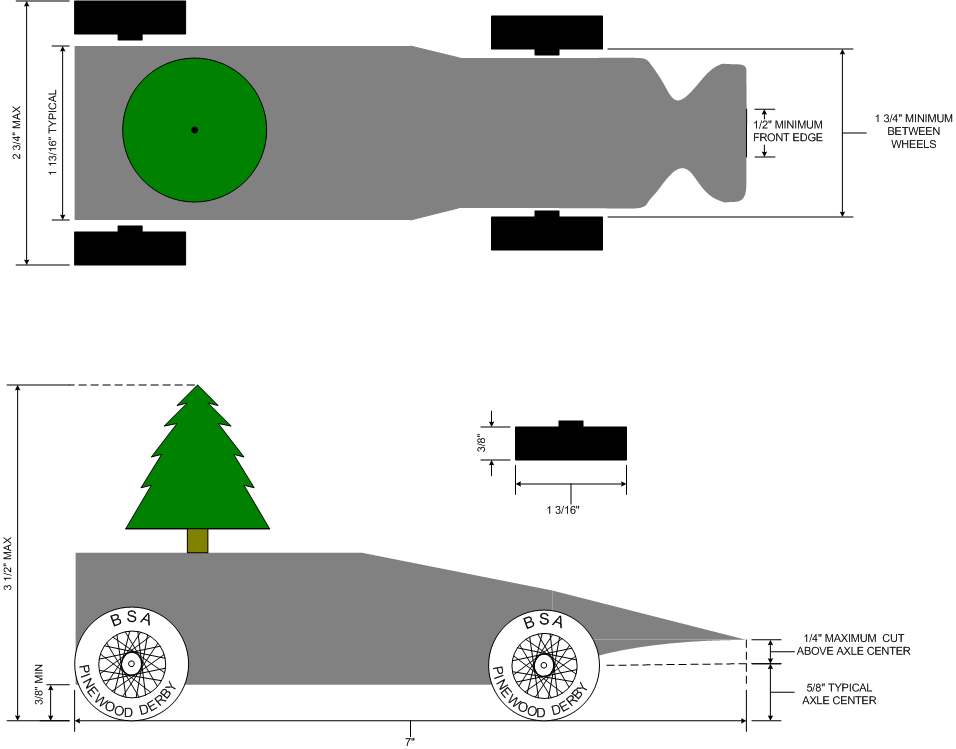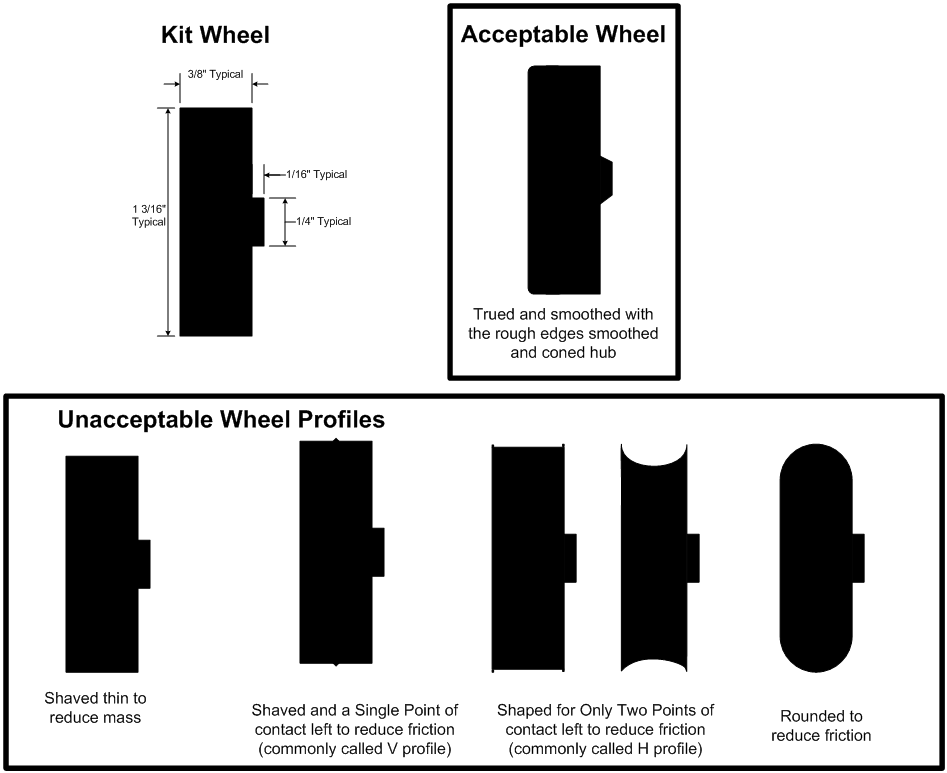Chief Black Dog District Pinewood Derby
Grand Prix Race Car Rules
CUB Scout Division:($6.50
entry fee)
OVERALL: All cars must be built for the current Pinewood
Derby Season.† NO REPEATS.
ONLY OFFICIAL BSA PINEWOOD DERBY
KIT AND PARTS may be used.† Cars that
were purchased completed may not be used.†
If the builder lacks the resources to cut out a car from a stock block
of wood, attendance at one of the district provided workshops is strongly
encouraged.† Alternately, a pre-shaped
block may be purchased to be used with the stock BSA Wheels and Axles.
Cars must be tuned or aligned by
the racer, adult supervision is encouraged.†
Cars may not be sent to third party facilities for tuning or other
performance enhancements.
DIMMENSIONS: Car cannot be more than 2 3/4 inches wide.† The maximum height is 3 inches. Car cannot
be more than 7 inches long.† Since the
starting pins are round, the minimum width of the front of the car is Ĺ inch.
The front end may be no more than ľ inch above the axle line. The car body must
be at least 1 3/4 inches wide at the axles. It must clear the ground by at
least 3/8 inch at the guide rail(s). There should be an unpainted, unfinished
wood surface on the underside of the car at least 1/2 x 1" (12 x 26 mm) to
be used for an identifying stamp.† (For
help see diagrams)
WEIGHT: Finished car cannot weigh more than 5.0 ounces. The
weight shown on the Official Race Scale is final. IF a scale with higher
precision is used measurements will be rounded to 5.0 ounce below 5.050
ounce.† All car parts and materials must
be firmly attached.† No moveable weights
are allowed.
WHEEL PLACEMENT: If desired, you may change the wheelbase
(distance between front and rear axles). The four wheels, two on each side of
the car, must be placed such that the car will straddle the lane guide.
WHEELS: Use only Official Scout Grand Prix wheels. All
lettering, both inside and outside, must remain and be visible.† The fluting and other BSA markings on the
outside wheel area must remain visible. There must be at least four wheels on
the car, however, it is not required that all four wheels make contact with the
track surface. The wheels must be attached directly to axle and spin
freely.
†
Can do: Outer wheel surface and inner edge of tread may be
lightly sanded, shaved, or polished to remove surface imperfections and mold
casting burrs,. The inner end of the hub may be
slightly coned.† The outer surface of the
wheel, where the axle head rubs, may be leveled.† The axle hole/bore may be smoothed or
polished.†
Can NOT DO: No part of the wheel
may be reshaped in any way in an attempt to lighten the wheel, minimize tread
contact or alter aerodynamics.†
Alteration of the tread contact surface is not allowed, i.e. curved, H
or V treads are not allowed.† Beveling,
tapering, thin sanding, or wafering of the wheels is
prohibited. †You may not use bearings,
washers or bushings. You may not drill holes in the sidewalls.† Filling of tread surface with other material
is not allowed.
†††††††††††††††††††††††††††††††††††† (For help
see diagrams)
AXLES: Axle Heads may be deburred
but may not be made smaller. †Only BSA axles are allowed with an
overall diameter of no less than .084 inches (2.13mm). Some polishing and/or
modification is allowed as long as overall diameter is
not reduced.† Axles must not be connected
to any device that mechanically alters rotation and spin.
SPRINGING: The car may not ride on any type of springs.
DETAILS: Details such as Steering Wheel, Driver, Decals,
Painting, Interior Details are okay. The finished car
with details must meet the maximum length, width and weight rules.† Cars with wet paint will not be accepted.
ATTACHMENTS: The car must be freewheeling with no starting
devices.
LUBRICATION: The recommended type is dry powdered graphite.
You may use any other lubricant, be careful since some other types can soften
the plastic of the wheels.† No hubcaps
will be allowed.† No graphite may be
applied outside of the designated workshop area inside the building. Over-application
of lubricant which results in excessive shedding onto the track is not allowed.
Approved lubricants include (but are not limited to) dry powered ones like graphite
or Teflon, and thin film lubricants like Nyloil or Krytox.† Other known
lubrication methods that are allowed are Pledge and silicon waxes.
INSPECTION: Each car must pass inspection by the Official
Inspection Committee before it may compete. The Inspectors will disqualify any
car not meeting these rules. Any adult or scout may appeal the findings of the
Inspectors to the Race Committee Chair-person, whose decision is final.† After acceptance only starters and judges
will handle the cars.
REPAIRS: Any car losing wheels or any part that prevents it
from running cannot be repaired after the inspection and weigh in.† EXCEPTION:†
Race officials may authorize repairs when damage is caused by collision
with another vehicle or object.† The Cub
Scout is in charge of making all car repairs. Guidance is allowed and
encouraged.† Ideally repairs can be done
before the next heat that the car is in starts.†
After the car is repaired Officials will run the race again.† If the car cannot be repaired before itís next race starts, that race will also be delayed until
the end of the races.
BEHAVIOR: GOOD SPORTSMANSHIP AND BEHAVIOR IS EXPECTED. Race
Officials may ask anyone not following this rule to leave
OPEN Division: ($15 entry fee)
OVERALL:† All cars
must be built for the current Pinewood Derby Season.† NO REPEATS.
Cars that were purchased completed
may not be used.† If the builder lacks
the resources to cut out a car from a stock block of wood, attendance at one of
the district provided workshops is strongly encouraged.† Alternately, a pre-shaped block may be
purchased to be used.
WHEELS: Modified wheels must conform to the following
specifications:
A.
Wheels must be 31mm diameter or smaller.
B. Wheels
must be constructed of plastic, rubber, or polyurethane.
C. Wheel
hubs may be made of metal, but may never come in direct surface contact with
the track.
There must be at least four wheels
on the car, however, it is not required that all four wheels make contact with
the track surface. The wheels must be attached directly to axle and spin
freely.
AXLES: Axles must
not be connected to any device that mechanically alters rotation and spin.
DIMMENSIONS, WEIGHT, WHEEL PLACEMENT, SPRINGING, DETAILS, ATTACHMENTS, LUBRICATION, INSPECTION, REPAIRS and BEHAVIOR: Same as Cub Scout Division
Questions and comments can be directed to:
Warren Kalsow††††††††††††† (c)612-801-7827†††† †††††††††††††††††††
848 Greening Drive†††††††† (w)952-883-5536




